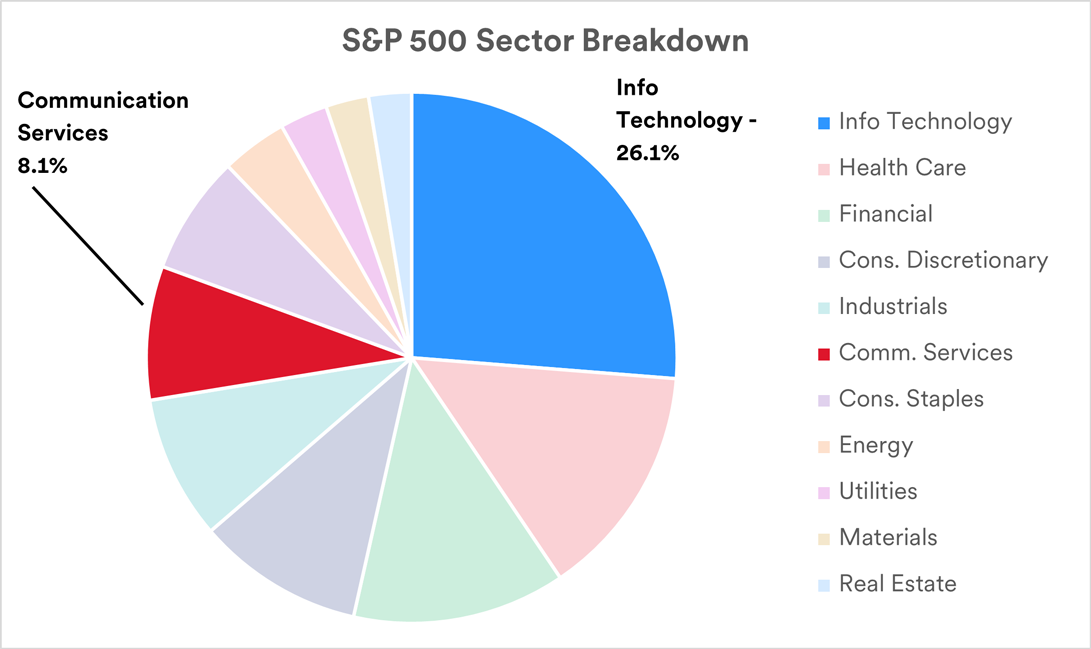
Key takeaways
The technology segment of the stock market represents some of the most prominent companies in the market today.
Technology is ever-changing, which means the search for investment opportunities in this segment of the market needs to be attuned to an evolving landscape.
Tech stocks soared between 2019 and 2021, but today’s environment may be less hospitable.
Investors have long considered the technology sector to be one of the more exciting segments in the stock market. Innovations in the technology arena often have a visible impact on society, capturing the public’s imagination and garnering the attention of investors.
“Fast is getting faster, and speed, scale and efficiencies across the board don’t happen without technology,” notes Terry Sandven, chief equity strategist at U.S. Bank. “To a large degree, technology is impacting all sectors of the economy in all walks of life.”
Information technology stocks currently represent the largest sector of the benchmark S&P 500 Index, more than a quarter of the index’s value. When you add in communications services stocks, many of which connect with the technology arena, the group represents more than one-third of the S&P 500.1

Source: S&P Dow Jones Indices as of March 31, 2023. For illustrative purposes only.
This means that individuals who invest in a broad stock market index already have significant exposure to technology stocks. How should investors view this sector of the market and how can it affect a portfolio?
An ever-evolving tech sector
For many investors, ‘FAANG’ stocks immediately spring to mind when considering technology companies. FAANG is an acronym that refers to the stocks of five prominent U.S. companies: Meta Platforms (formerly known as Facebook), Amazon, Apple, Netflix and Alphabet (formerly known as Google).
However, it’s helpful to keep in mind that technology stocks represent a broad range of companies and can even cut across a variety of sectors within the broader stock market. For example, Amazon is listed as a Consumer Discretionary company. And firms such as Alphabet and Meta, two other highly visible web-based companies, fall under the Communications Services category. Within the traditional Information Technology sector, you will find stocks like Apple, Microsoft, NVIDIA and Cisco Systems.
“By its very nature, technology evolves over time. This results in new companies rising to the forefront while other companies fade away,” says Sandven. “For example, the onset of digital cameras and the capability of mobile phones to deliver quality photography ended the reign of what were once considered innovative companies like Kodak and Polaroid.”
The technology sector continues to evolve. “Today much of the opportunity appears to be tied to artificial intelligence (AI), machine-learning commerce, cloud computing, data analytics and data security services,” says Sandven. In addition, he cites medical advancements as another area contributing to technological breakthroughs. “For example, wearable devices that track exercise patterns and provide other readings may provide key information to help medical professionals deliver specific advice to benefit your health.”
Artificial intelligence advances
In recent months, significant attention has been given to advancements in the area of generative AI, specifically applications such as ChatGPT. Generative AI systems are designed to develop original content by applying information the system “learns” from an existing data base.
“Fast is getting faster, and speed, scale and efficiencies across the board don’t happen without technology.”
Terry Sandven, chief equity strategist at U.S. Bank
“What you’re seeing with the newest developments in AI is the ability to resolve a question by analyzing it, pulling together the necessary and available data and then delivering on the query,” says Rob Haworth, senior investment strategy director at U.S. Bank. “This has the potential to lead to much more innovation and greater efficiencies.” While the technology shows impressive potential, Haworth believes some perspective is helpful. “This appears to represent more of a technological evolution, rather than a revolution.”
Applications for advanced AI could be widespread, according to Sandven. “It’s already adding efficiencies in the operation of contact centers, meeting transcriptions, public safety, industrial applications, credit card fraud prevention, and transportation.”
Some critics of AI have suggested the pace of development in this technology needs to be slowed given uncertainties about the potential ramifications of AI. Sandven says there are reasons to look on the latest AI technological advances with some skepticism. “We don’t know yet what it will mean for labor markets or our standard of living,” says Sandven. “It may prove to be very disruptive from an economic perspective, but the jury is still out.”
A changing investment landscape for tech stocks
Through most of the 2010s and into the early years of the 2020s, technology stocks prospered. Most notably, in a brief, three-year span from December 31, 2018, until December 31, 2021, the Standard & Poor’s 500 Communication Services and Information Technology Index generated a total return of 160%, far outpacing the broader stock market, which earned an already impressive 100% return over the same period.
A combination of stable economic growth, low inflation and low interest rates proved to be a fertile environment for many growth stocks, including technology issues. While a number of technology companies generated solid earnings growth, investors bid up prices of some stocks to very high multiples (a stock’s price-to-earnings ratio). Given that multiples far exceeded historic averages for some stocks, investors showed their faith in the ability of select companies to generate significant earnings growth far into the future. However, the environment changed once the Federal Reserve implemented a significant shift in its monetary policy, including a rapid hike in the federal funds rate, from near 0% in early 2022 to 5.0% (upper end of fed funds target rate) by March 2023.
“Investors were willing to pay a premium for the potential future growth of technology stocks under more favorable inflation and interest rate circumstances,” says Haworth. “The environment is far different today, so investors should expect that it will be hard for technology stocks to replicate results that were generated in a period of low inflation and interest rates.” Haworth says as a result, market multiples are less likely to reach the lofty, pre-2022 levels given that investors can earn more competitive returns today from fixed income investments. He also notes that some of the realities of the business environment create additional issues for the technology sector. “Higher borrowing costs and higher interest rates may challenge technology companies to generate the same earnings growth,” says Haworth.
The change in the underlying economic environment took a toll on technology stocks in 2022. The Communication Services and Information Technology Sector of the S&P 500 declined more than 31%, lagging what was already a down year for the broader S&P 500 (down 18%).2
However, the sector rebounded in the first quarter of 2023, gaining 21.2%, easily outpacing what was already considered a solid quarter of performance for the broader S&P 500 index (up 7.5%). Nevertheless, the current economic environment may be less hospitable to the technology sector than was the case prior to 2022.

Source: S&P 500 Index as of March 31, 2023. Information Technology and Communication Services represent a subset of stocks included in the S&P 500. Past performance is no guarantee of future results. Index data shown is unmanaged and not available for direct investment. For illustrative purposes only.
The future for technology stocks
“Keeping in mind that technology stocks were among the worst performers in 2022, the recovery in the first quarter of 2023 may have been a ‘reflex rally,’” says Sandven. “It’s too early to say that happy days are here again, but over the long term, technology stocks can be expected to remain highly visible in the broader market.” Sandven believes that technology advancements will continue, which presents new investment opportunities.
“There is a wide degree of acceptance of technology among younger Americans, from the millennials (born between 1981 and 1996) and the generations that follow,” says Sandven. “They’ve built much of their lives around technology and seem more prepared to adapt to new advances.” He adds that it’s important to expect technology to evolve over time. “Some of today’s winning companies will ultimately fall to the wayside as technology changes and new, successful companies emerge.”
Haworth agrees that technology stocks have a bright future. “Innovations will continue to change the world and that will create investment potential,” says Haworth. Importantly, however, he notes that investors need to be selective in their approach to this sector of the market.
Sandven adds that to a certain extent, the core of what some technology companies deliver today can be considered a more stable segment of the U.S. economy. “The amount of data that is being created and captured is staggering. Data processing, analysis and distribution are becoming important backbones to how business gets done across the economy. In that lens, you could consider technology, to an extent, a defensive sector that can hold up well even in difficult market environments.”
At the same time, it’s also critical for investors to recognize that this segment of the market is subject to challenges. Historically, technology stocks have suffered through periods of significant decline, such as the “dot-com” bubble in the early 2000s. While some technology startups achieve tremendous success, many firms fail to get off the ground. In addition, factors such as increased regulation regarding AI and social media services (a subject that’s been discussed) is a potential concern on the horizon that could affect business prospects. Investors should be certain to weigh these factors as they consider the role of technology stocks in their portfolios.
Mutual funds and exchange-traded funds (ETF) that track a major index like the S&P 500 provide significant exposure to this prominent segment of the broader market. Technology is even more prominent in the NASDAQ Composite Index. It’s reasonable to expect that technology stocks will play a role in a broadly diversified portfolio.
As you assess the most effective ways to position your portfolio consistent with your goals and time horizon, be sure to consult with your financial professional.
The S&P 500 Index consists of 500 widely traded stocks that are considered to represent the performance of the U.S. stock market in general. It is an unmanaged index and direct investment in the index is not possible.
Tags:
Related articles

How far will the market correction go?
With stocks slipping in and out of bear market territory, learn how the market correction and ongoing volatility could impact your investments.

How to put cash you’re keeping on the sidelines back to work in the market
Don’t let market volatility and an uncertain economic outlook derail your disciplined investing strategy.
